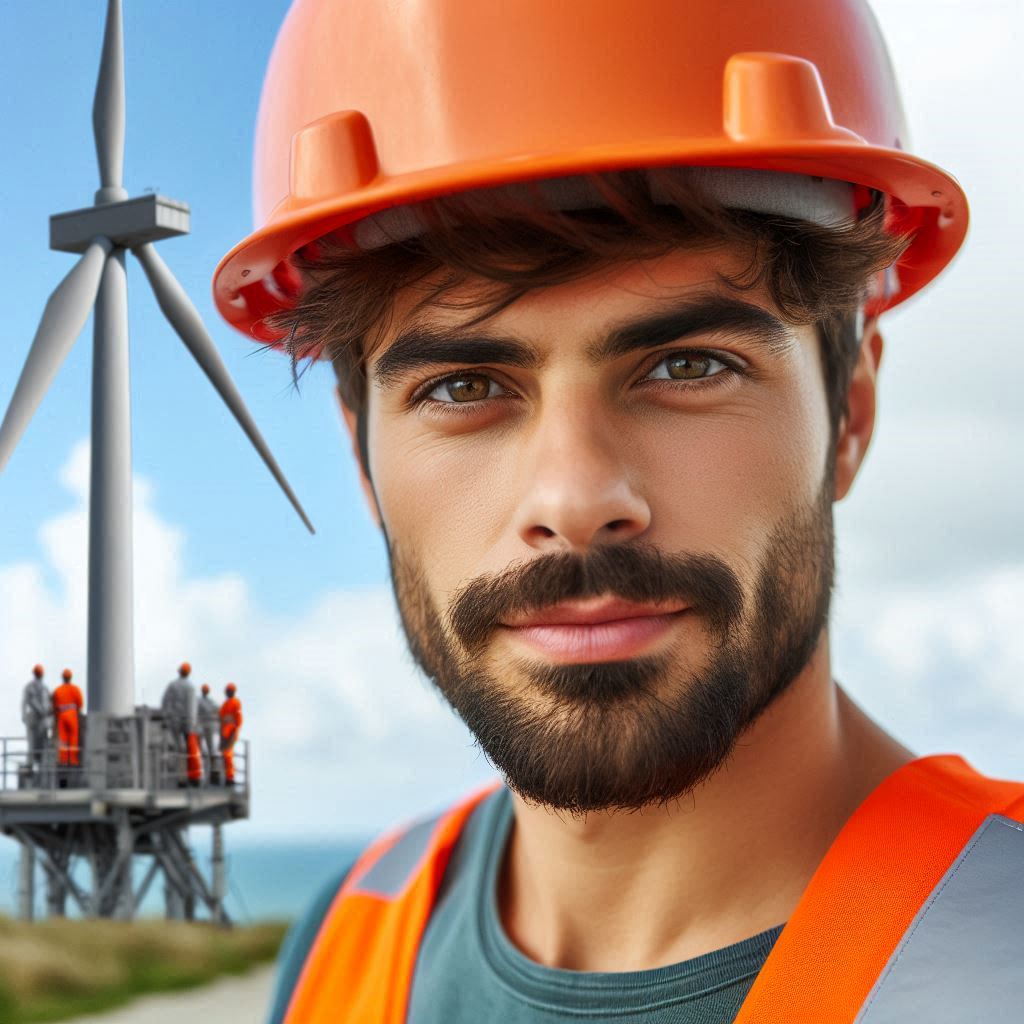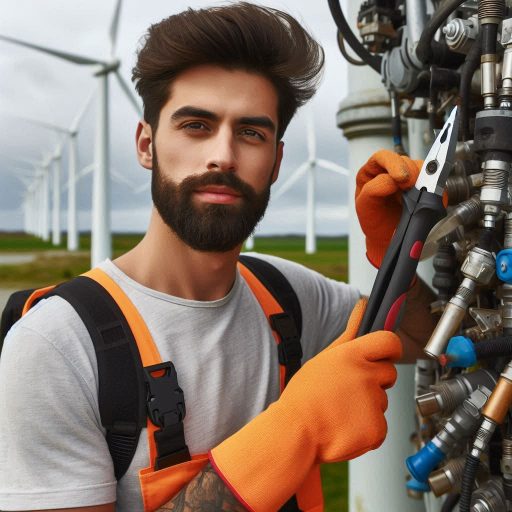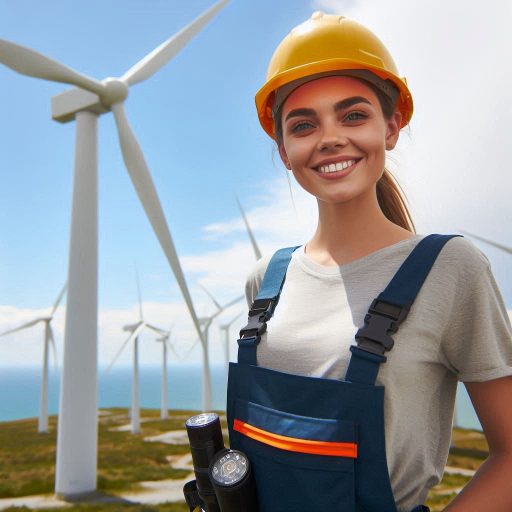Introduction
In this blog, we delve into the distinct roles of wind turbine technicians and wind engineers, two essential professions within the wind energy sector.
Wind turbine technicians focus on the hands-on aspects of wind energy production.
They are responsible for the maintenance, repair, and troubleshooting of wind turbines.
Their role is critical for ensuring that turbines operate efficiently, safely, and with minimal downtime.
Technicians perform routine inspections, address mechanical issues, and handle emergencies on-site.
On the other hand, wind engineers concentrate on the design, development, and optimization of wind turbine systems.
They work on creating more efficient turbine designs, integrating new technologies, and improving overall performance.
Their work involves extensive research, simulation, and analysis to enhance the efficiency and reliability of wind turbines.
The importance of renewable energy sources, such as wind power, cannot be overstated.
Wind energy plays a crucial role in reducing reliance on fossil fuels and mitigating climate change.
It provides a sustainable solution to meet the world‘s growing energy needs while minimizing environmental impact.
Comparing the roles of wind turbine technicians and wind engineers sheds light on how each profession supports the advancement of wind energy.
Job Description of a Wind Turbine Technician
Responsibilities on a Day-to-Day Basis
Wind turbine technicians and wind engineers have distinct daily responsibilities.
Technicians focus on hands-on tasks such as maintenance and repairs.
They inspect turbines, troubleshoot issues, and perform routine servicing.
Technicians ensure turbines operate efficiently and safely.
Engineers, on the other hand, are involved in design and development.
They work on optimizing turbine performance and improving technology.
Engineers conduct simulations and analyze data to enhance turbine efficiency.
While technicians address immediate operational issues, engineers focus on long-term improvements and innovations.
Skills Required for the Role
Technicians require practical skills in mechanical and electrical systems.
They must be adept at using diagnostic tools and performing repairs.
Attention to detail and problem-solving skills are crucial for identifying issues.
Engineers need strong analytical skills and proficiency in design software.
They must understand complex engineering principles and have expertise in aerodynamic and structural analysis.
Both roles require strong communication skills for coordinating with teams and reporting findings.
Work Environment and Physical Demands
Technicians work directly at wind farms, often in challenging environments.
They may be required to climb turbines, work at heights, and endure various weather conditions.
Physical fitness and safety awareness are essential for this role. Engineers typically work in office settings or laboratories.
Their work involves extensive use of computers for simulations and analysis.
Engineers may occasionally visit sites for testing or evaluations, but their physical demands are generally less intense compared to technicians.
Training and Education Needed
Wind turbine technicians typically need a technical diploma or associate degree in a related field.
They often receive specialized training in turbine maintenance and repair.
Certification programs are available to enhance their skills and career prospects.
Wind engineers usually hold a bachelor’s degree in mechanical or electrical engineering.
Advanced positions may require a master‘s degree or higher education in engineering.
Engineers often need experience in wind energy projects and may pursue additional certifications in specialized areas.
Basically, wind turbine technicians and wind engineers have different roles and responsibilities.
Technicians focus on maintenance and repairs, requiring practical skills and physical stamina.
Engineers concentrate on design and optimization, needing strong analytical skills and a background in engineering.
Their work environments and training requirements also differ, with technicians working in the field and engineers primarily in office settings.
Understanding these differences helps in choosing the right career path in the wind energy sector.
Job Description of a Wind Engineer
Responsibilities in Designing Wind Farms
Wind turbine technicians and wind engineers play different roles in designing wind farms.
Wind engineers focus on planning and optimizing the layout of wind farms.
They assess site conditions and determine the best locations for turbines.
Engineers analyze wind patterns, land topography, and environmental impact to design efficient wind farms.
Technicians, on the other hand, implement and maintain these designs.
They handle the installation, repair, and maintenance of turbines.
While technicians ensure that turbines operate smoothly, engineers design systems to maximize energy production and efficiency.
Skills Needed Like Computer Modeling and Data Analysis
Wind engineers require advanced skills in computer modeling and data analysis.
They use specialized software to create models of wind farms.
These models help predict turbine performance and optimize placement.
Engineers analyze data from simulations to make informed decisions about design and layout.
Technicians, while also skilled, focus more on practical applications.
They use diagnostic tools to troubleshoot issues and perform maintenance.
Their work requires knowledge of mechanical and electrical systems, rather than in-depth data analysis.
Work Environment in Offices and On-Site
Wind engineers typically work in office environments.
They spend time analyzing data, creating models, and preparing reports.
Their work often involves collaboration with other engineers, planners, and stakeholders.
Engineers may visit sites occasionally to assess conditions and validate their designs.
Wind technicians work on-site at wind farms.
They perform hands-on tasks such as installing and repairing turbines.
Technicians often work in varying weather conditions and at heights.
Their work is more physically demanding compared to the office-based tasks of engineers.
Education Requirements Including Degrees and Certifications
Wind engineers generally need a bachelor’s degree in engineering, such as mechanical or electrical engineering.
Advanced positions may require a master‘s degree or higher.
Engineers often obtain certifications in specialized areas like wind energy or environmental impact assessments.
Wind technicians usually require a relevant associate degree or vocational training in wind energy technology.
Certifications from recognized organizations, such as the North American Board of
Certified Energy Practitioners (NABCEP), can enhance their qualifications.
While less formal education is needed compared to engineers, hands-on training is crucial.
Therefore, wind engineers and wind turbine technicians have distinct roles in the wind energy sector.
Engineers design wind farms using computer modeling and data analysis, typically working in offices with occasional site visits.
Technicians, working on-site, focus on the practical aspects of turbine installation and maintenance.
Both roles require specific education and skills, with engineers needing advanced degrees and certifications, while technicians benefit from vocational training and industry certifications.
Salary and Job Outlook for Wind Turbine Technicians
Median Salary Range and Potential for Growth
Wind turbine technicians and wind engineers both play critical roles in the wind energy sector, but their career paths differ significantly.
Wind turbine technicians typically earn between $50,000 and $70,000 annually, depending on experience and location.
Entry-level positions start at the lower end, while experienced technicians with specialized skills can command higher salaries.
The potential for salary growth is steady, with experienced technicians seeing gradual increases and opportunities for supervisory roles.
Wind engineers, on the other hand, often earn between $80,000 and $120,000 per year.
This higher salary reflects the advanced education and expertise required for the role.
Engineers with advanced degrees or significant experience can achieve salaries beyond this range.
The potential for growth is substantial, with opportunities for higher-level positions such as project managers or senior engineers.
Demand for Technicians in the Renewable Energy Sector
The demand for wind turbine technicians is robust and growing.
As the renewable energy sector expands, more wind farms are being established, increasing the need for maintenance and repair professionals.
Technicians are essential for ensuring that turbines operate efficiently and reliably.
This high demand translates into strong job security and a favorable job outlook.
Conversely, the demand for wind engineers is also growing but in different ways.
Engineers are needed to design new turbine models, optimize performance, and develop innovative technologies.
As wind energy technology advances, engineers play a crucial role in driving progress.
The demand for engineers is linked to technological development and large-scale projects, creating a steady need for their expertise.
Opportunities for Advancement or Specialization
Both wind turbine technicians and wind engineers have distinct paths for advancement and specialization.
Technicians can pursue certifications or training to become specialists in areas like blade repair or advanced diagnostic systems.
They might also move into supervisory or management roles within maintenance teams.
Specialized training can lead to roles such as lead technician or maintenance supervisor, which come with increased responsibilities and higher pay.
Engineers, meanwhile, have opportunities for advancement through roles such as senior engineer, project manager, or director of engineering.
They can also specialize in areas like aerodynamics, structural analysis, or renewable energy integration.
Advanced education and experience open doors to leadership positions or roles in research and development.
In review, wind turbine technicians and wind engineers each offer unique career opportunities within the renewable energy sector.
Technicians enjoy steady demand and opportunities for growth through specialization and supervisory roles.
Engineers benefit from higher salaries and advancement opportunities tied to technological innovation and large-scale projects.
Both roles are integral to the sector, with distinct pathways for career development and specialization.
Read: Continuing Education for Radiologic Technologists
Salary and Job Outlook for Wind Engineers
Median Salary Range and Potential for Growth
The median salary for wind turbine technicians typically ranges from $50,000 to $70,000 annually.
This range can vary based on experience and location.
Technicians with advanced skills or certifications may earn higher salaries.
The potential for salary growth exists as technicians gain experience and take on more complex tasks.
Wind engineers generally earn more, with median salaries ranging from $80,000 to $120,000 per year.
Engineers’ higher earnings reflect their advanced education and technical expertise.
Both roles offer opportunities for salary advancement, with engineers often having a higher earning potential due to their specialized knowledge.
Demand for Engineers in Wind Energy Projects
The demand for engineers in wind energy projects is growing steadily.
Engineers design and optimize wind turbines, contributing to more efficient energy production.
As wind energy projects expand, the need for skilled engineers increases.
Engineers play a crucial role in developing new technologies and improving existing systems.
Their expertise is essential for meeting the technical challenges of large-scale wind farms.
The growth in renewable energy investments drives up demand for engineers.
This demand ensures that skilled engineers are highly sought after in the job market.
Transform Your Career Today
Unlock a personalized career strategy that drives real results. Get tailored advice and a roadmap designed just for you.
Start NowOpportunities for Career Advancement and Higher Pay
Career advancement opportunities are available for both wind turbine technicians and engineers.
Technicians can progress to supervisory roles or specialize in advanced maintenance techniques.
They may also move into roles such as training instructors or field service managers.
Engineers can advance to senior positions, project managers, or specialized roles in research and development.
Advanced degrees and certifications further enhance career prospects and earning potential.
Engineers often have more opportunities for career growth, given their higher educational requirements.
Both paths offer potential for higher pay as professionals advance in their careers.
Generally, wind turbine technicians and wind engineers have distinct career paths with different salary ranges and growth potential.
Technicians typically earn between $50,000 and $70,000, while engineers earn between $80,000 and $120,000.
The demand for engineers is high due to their role in optimizing wind energy projects.
Career advancement opportunities exist for both roles, with engineers generally having higher earning potential and more growth opportunities.
Both career paths offer rewarding opportunities in the expanding wind energy sector.
Read: Radiologic Technologist: Work Environment Insights
Comparison of Working Conditions
Physical Demands of Being a Technician vs. a More Office-Based Engineer
The physical demands of a wind turbine technician differ significantly from those of a wind engineer.
Technicians often work in challenging conditions, including heights and harsh weather.
They perform hands-on tasks such as installing, maintaining, and repairing turbines.
This job requires physical strength, endurance, and the ability to handle tools and equipment.
In contrast, wind engineers typically work in office environments.
Their tasks involve designing, analyzing, and planning wind turbine systems.
Engineers spend much of their time using computers and software to develop models and simulations.
The physical demands for engineers are generally lower compared to technicians.
Travel Requirements for Engineers Visiting Wind Farms
Wind engineers may travel to wind farms, but their travel requirements are less frequent than those of technicians.
Engineers often visit wind farms for site assessments, system evaluations, or troubleshooting specific issues.
These visits can be periodic and planned in advance, focusing on specific project phases or problems.
Technicians, however, often travel more regularly to maintain and repair turbines across various locations.
Their work may involve traveling to remote or offshore wind farms.
This travel is essential for their role, as they need to address issues directly at the turbine sites.
Work Schedules and Overtime Expectations for Both Professions
Work schedules and overtime expectations also differ between wind turbine technicians and wind engineers.
Technicians often work irregular hours, including weekends and holidays.
Their schedules depend on the operational needs of the wind farms and may involve emergency repairs.
Wind engineers usually have more regular office hours, typically from Monday to Friday.
Their work is project-based, and overtime is generally related to deadlines or project milestones.
Engineers may need to work extra hours occasionally but usually have more predictable schedules compared to technicians.
In general, the physical demands of wind turbine technicians involve hands-on work in challenging conditions, while wind engineers have a more office-based role with lower physical demands.
Engineers may travel to wind farms occasionally, while technicians often travel regularly for maintenance tasks.
Work schedules for technicians are more variable and include potential overtime, while engineers generally work regular hours with occasional overtime based on project needs.
Each role plays a crucial part in the wind energy sector, with distinct demands and expectations.
Read: Future of CAD Technician Jobs in Engineering

Advantages of Becoming a Wind Turbine Technician
Hands-On Work with Technology and Machinery
Wind turbine technicians and wind engineers have distinct roles, especially regarding hands-on work with technology and machinery.
Technicians are directly involved in the installation, maintenance, and repair of wind turbines.
Their job requires hands-on interaction with various mechanical and electrical systems.
Technicians climb towers, troubleshoot mechanical issues, and replace faulty components.
They work with tools and equipment, ensuring turbines operate efficiently and safely.
In contrast, wind engineers typically focus on the design, analysis, and optimization of wind turbine systems.
While they may oversee the installation process, they do not engage with the machinery on a daily basis.
Their role involves more theoretical work, such as simulations and design improvements.
Opportunities for Learning on the Job
Both careers offer substantial opportunities for learning on the job, but the experiences differ.
Wind turbine technicians gain practical knowledge through direct involvement with turbines.
They learn to handle unexpected issues, adapt to new technologies, and refine their skills through hands-on work.
On-the-job learning often includes troubleshooting and problem-solving in real-world scenarios.
Technicians may also receive specialized training to stay updated with evolving technology and safety practices.
Wind engineers, however, learn through project experience and research.
They often work on complex projects, learning about new technologies, materials, and design methodologies.
Their learning involves analyzing data, conducting simulations, and applying engineering principles.
Engineers may attend conferences, participate in research projects, and collaborate with other experts in the field.
This continuous learning process helps them advance their expertise in turbine design and optimization.
Potential for International Work in the Wind Energy Sector
Both wind turbine technicians and wind engineers have opportunities for international work, though the nature of their roles differs.
Technicians may travel globally to install and maintain wind turbines in various countries.
International work allows them to gain experience with different turbine models and operating conditions.
They may work on large wind farms in diverse environments, from offshore installations to remote locations.
Wind engineers also have international opportunities, often working with multinational teams or on global projects.
Their roles may involve designing turbines for international markets, analyzing data from global projects, or collaborating with engineers from other countries.
Engineers may also work on international research projects, contributing to advancements in wind technology.
Overall, both careers offer unique opportunities for hands-on work, learning on the job, and international experiences.
Technicians engage directly with technology and machinery, gaining practical skills and experience.
Engineers focus on design and optimization, learning through research and project work.
Both roles contribute to the advancement of the wind energy sector and offer diverse career paths.
Read: Interview Tips for Aspiring Radiologic Technologists
Advantages of Becoming a Wind Engineer
Higher Earning Potential and Job Stability
Wind engineers generally enjoy higher earning potential compared to wind turbine technicians.
Engineers often have advanced degrees and specialized skills, which lead to higher salaries.
Their roles involve designing and optimizing wind energy systems, which commands a premium in the job market.
Job stability for wind engineers is strong due to the growing demand for renewable energy solutions.
The increasing investment in wind energy projects supports long-term employment opportunities for engineers.
Technicians also have stable job prospects, but engineers typically see higher compensation due to their advanced expertise.
The growth in renewable energy further ensures job security for both roles.
Innovation and Problem-Solving in Designing Wind Energy Systems
Wind engineers focus on innovation and problem-solving in designing wind energy systems.
They develop new technologies and improve existing systems to enhance efficiency.
Engineers tackle complex challenges, such as optimizing turbine performance and integrating new materials.
Their work involves research, modeling, and simulations to create effective solutions.
Engineers are responsible for designing systems that can withstand varying environmental conditions.
Their role is crucial in advancing wind energy technology and addressing emerging challenges.
Innovative designs by engineers contribute to more efficient and cost-effective wind energy systems.
Opportunities for Research and Development in Renewable Energy Technologies
Wind engineers have significant opportunities for research and development in renewable energy technologies.
They engage in cutting-edge research to advance wind energy technologies and solutions.
Engineers explore new materials, turbine designs, and energy storage methods.
Their work drives technological progress and improves the performance of wind energy systems.
Research opportunities allow engineers to contribute to sustainable energy solutions and address global energy challenges.
Technicians, while crucial for maintenance and operations, are less involved in research and development.
Engineers play a key role in pushing the boundaries of renewable energy technologies.
In summary, wind engineers benefit from higher earning potential and job stability due to their specialized skills and advanced roles.
They engage in innovation and problem-solving to design and optimize wind energy systems.
Their work includes substantial opportunities for research and development in renewable energy technologies.
While wind turbine technicians play an essential role in the industry, engineers often have greater involvement in advancing and improving wind energy solutions.
The evolving field of renewable energy offers dynamic and rewarding career paths for both engineers and technicians.
Discover More: Aerospace Engineering and National Security
Conclusion
Wind turbine technicians and wind engineers play crucial roles in the wind energy industry.
Technicians are hands-on workers responsible for maintenance, repairs, and installation of wind turbines.
On the other hand, wind engineers are involved in the design, development, and optimization of wind energy systems.
It’s important to recognize that both career paths are essential for the growth and success of the renewable energy sector.
Wind turbine technicians ensure that the turbines are functioning smoothly, while wind engineers focus on improving efficiency and performance.
Showcase Your Business Today
Reach thousands of readers actively exploring professional services. Publish your business profile and grow your audience now.
Publish NowKey differences between wind turbine technicians and wind engineers
- Wind turbine technicians: hands-on maintenance, repairs, and installation.
- Wind engineers: design, development, and optimization of wind energy systems.
As the demand for renewable energy continues to rise, there is a growing need for skilled professionals in the wind energy industry.
Both wind turbine technicians and wind engineers have unique skill sets that contribute to the advancement of wind energy technology.
Encouragement to explore both career paths and consider the future of renewable energy
Whether you’re interested in working with the technical aspects of wind turbines or contributing to the innovative solutions in wind energy systems.
Both career paths offer rewarding opportunities for growth and impact in the renewable energy sector.
The importance of skilled professionals in advancing the wind energy industry
Skilled professionals, including wind turbine technicians and wind engineers, are crucial in driving the growth and development of the wind energy industry.
Their expertise and dedication are essential for creating sustainable and efficient wind energy solutions for a greener future.
[E-Books for Sale]
The Big Book of 500 High-Paying Jobs in America: Unlock Your Earning Potential
$19.99 • 500 High-Paying Jobs • 330 pages
Explore 500 high-paying jobs in America and learn how to boost your career, earn more, and achieve success!
See All 500 High-Paying Jobs of this E-Book
1001 Professions Without a Degree: High-Paying American Jobs You Can Start Now
$19.99 • 1001 Professions Without a Degree • 174 pages
Discover 1001 high-paying jobs without a degree! Unlock career tips, skills, and success strategies for just $19.99!




